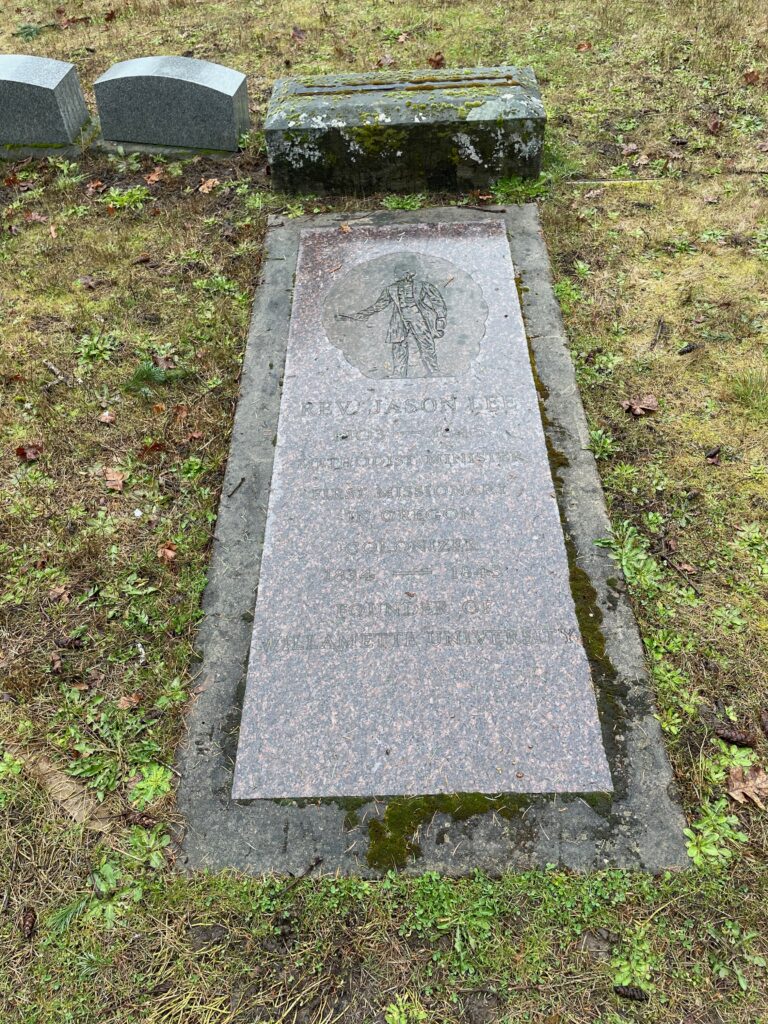Erik Visits an American Grave, Part 1,741
This is the grave of Jason Lee.

Born in 1803 in Stanstead, Quebec, Lee was the youngest of 14 siblings. He was poor and by 1816 he was on his own, working to support himself. In 1826, Lee had a conversion experience and became a Methodist. He went to Methodist seminaries and became a missionary. He went back to Stanstead in 1830 and taught school and worked as a minster for a couple of years. But he wanted to convert the Tribes. He hoped to do so in Canada and applied to work in Canada in 1832, but that didn’t work out. In 1833, he tried again, this time in the United States. By this time, a few Nez Perce and Bitteroot Salish who had converted to Christianity traveled down the Missouri River to St. Louis. There, William Clark was still a very big deal in Indian Country. They appealed to him to send missionaries out to their people. Clark was certainly very interested in this idea and newspapers around the country published calls for missionaries.
A small group of missionaries responded to this call, including Lee. They were pretty organized and under the leadership of Nathaniel Wyeth. They left in 1834 and headed West. Were these dudes super judgmental? Oh you know they were. In fact, I’d argue that you actually can’t be a missionary if you believe in equality of people or culture because you are inherently starting at the point where you need to say that they are inherently inferior because you think they need to change their fundamental cosmology. In any case, Lee had a way of talking about how certain tribes were dirty, barely human, etc. But then that’s why he became a missionary. The trip west ended at Fort Vancouver, owned by the Hudson’s Bay Company. There they met John McLoughlin. He suggested the missions in the West be in the Willamette Valley rather than in the inland West. I assume that at least part of this was that the Tribes in the Valley were more sedentary and also less inclined toward military action.
So Lee started a mission northwest of what is today Salem, Oregon, in a little settlement of Catholic HBC former employees and their Native wives. Now, Lee absolutely believed in the inevitability and desire of white dominance over Natives in Oregon. He really saw no place for indigenous people in a white man’s civilization. But wanted to convert them before they inevitably died out. He had no interest in Native culture at all, hardly uncommon at the time of course. He immediately sought to ban alcohol in Oregon and fought a former trapper who wanted to start a distillery, mostly to sell to Indians. The guy backed down. He then went back to the east in 1838, both because there were problems of communication between his mission and its eastern benefactors (not surprising given he was relying on a few travelers or ships to send or receive messages) and to promote the Oregon project under American control and not the British. He did a lot of a new kind of missionizing–convincing white settlers to take a shot in Oregon, which required traveling by land. This started the process of the flood of whites to come to the Willamette Valley over the next few years, bringing in the Oregon Trail. A few more missionaries came out too.
One of the other things Lee did was work to bring cattle to the Northwest. This was so rare at the time that there’s a whole movie about it–though Lee does not have a role in it–Kelly Reichardt’s superb First Cow. As an aside, Kelly Reichardt’s deep and very personal dives into Oregon’s past and present has allowed her to surpass Gus Van Sant as the greatest ever Oregon director, not because I am dismissing films such as Drugstore Cowboy or My Own Private Idaho, both of which are astoundingly great, but because she understands the white supremacist yet proud frontier past of Oregon very deeply and makes complicated films about it that might not have massive mainstream appeal but are in fact very fine films. Anyway, Lee was very big on creating white economic dependence while using the remaining Native people as a labor force. So he also created the Indian Mission Manual Labor School to train them in things whites wanted.
Lee and the other missionaries really didn’t get along, there were all kinds of accusations both about Lee and from Lee, some over financial issues and some from other missionaries believing he wasn’t really concerned about Native souls, which may well have been true on both accounts.. In 1840, he moved the mission south, closer to Salem, built a new school, and tried to expand his little empire. Eventually though, he was relieved of his duties as superintendent. Upon hearing this from his friend Marcus Whitman, returning to his own ill-fated mission outside of modern Walla Walla, Lee got back east as soon as he could. While there, he went back to Quebec to visit his family and he died there of an unknown illness, in 1845. He was 41 years old.
Jason Lee is buried in Lee Mission Cemetery, Salem, Oregon. Obviously, given it was 1845, his body was not brought back to Oregon after his death. Rather, he was buried in Quebec and moved there in 1906.
If you would like this series to visit other people involved in the white domination over the Oregon Country, you can donate to cover the required expenses here. Nathaniel Wyeth is in Cambridge, Massachusetts and Joel Palmer is in Dayton, Oregon. Previous posts in this series are archived here and here.


